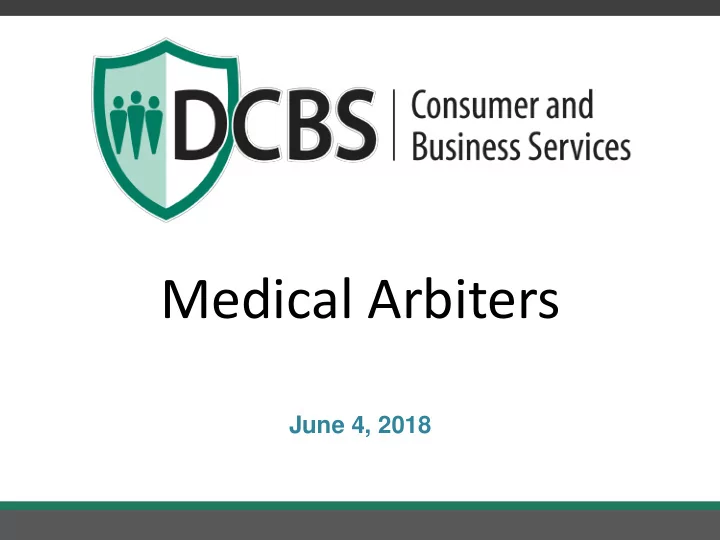

Medical Arbiters June 4, 2018
Workers’ Compensation Flowchart On-the-job injury or occupational disease. Worker remains eligible for certain medical and vocational services. Claim may reopen to process an aggravation or acceptance of a new Claim filed. or omitted condition. If reopening occurs, a new Notice of Closure would issue once the claim once again qualifies for closure. Nondisabling/disabling classification (unless denied within 14 days). Worker or insurer, within 30 days of Order on Nondisabling = No time loss authorized Reconsideration, may request WCB hearing. Disabling = Time loss and no reasonable The record is limited to the certified authorized or likelihood expectation of reconsideration record. of permanent disability. permanent disability. Order on Reconsideration issues. 60 Days to Accept or Deny Claim accepted for If requested, arbiter examination occurs. articulated Claim denied — Appeal conditions. Time loss right given. Time-loss and medical benefits A party may request Reconsideration of the payments stop. will continue as is Notice of Closure. found appropriate. Worker med stat or claim otherwise qualifies Notice of Closure (disabling claims only) — for closure. Insurer determines extent of disability.
History of the Reconsideration and Medical Arbiter Process 1990 statutory changes = The start of the medical arbiter process. At that time, legislators sought the following: • Faster resolution of disputes. • An appeal process to allow workers to receive benefits with little or no litigation. • Avoidance of gridlock between “dueling doctors” from the insurer and injured worker.
What Exactly is “Reconsideration”? Reconsideration An administrative process established for the review of disputed claim closures. Disagree with permanent impairment? A party may request a medical arbiter examination.
What can be Appealed in the Reconsideration Process? Insurer/Self- Insured Worker Disagreements Employer Disagreements with the findings with any aspect used to rate of the NOC impairment Must be made Must be made within 7 days of within 60 days the NOC of the NOC
The Division’s Role in Reconsideration The Appellate Review Unit (ARU) administers both the Reconsideration Process and the Medical Arbiter Program . ARU initially has 18 working days from the date of the request to issue an Order on Reconsideration. The time frame may be extended 60 days if additional information is needed. The most prevalent issue raised at reconsideration is a disagreement with impairment findings, resulting in more than 200 arbiter examinations per month .
The Purpose of the Medical Arbiter Examination • To help the division resolve disputes over impairment findings resulting from the compensable injury. • To provide an impartial, comprehensive evaluation of the worker’s impairment. • To report findings of impairment in conformance with the Disability Rating Standards (OAR 436-035).
Preparing for the Examination (or Records Review) Arbiters receive the following from ARU: • Case-specific arbiter questions • A copy of the worker’s medical record Only records sent to the division are to be reviewed by the arbiter • Billing instructions
Examples of Issues Addressed • Active (unassisted) ranges of motion. • Any injury or disease in contralateral joint? • Strength loss on 0-5/5 method and, if present, peripheral nerve(s) and/or nerve root innervating the muscles. • Sensation. • Hypersensitivity. • Significant limitation in the repetitive use of one or more body parts. • Vascular impairment (with definitions from rule provided).
Examples of Issues Addressed • Validity of findings. • Cause of any deficiencies – is it from the accepted condition(s) or their direct medical sequela? • Apportionment with any pre-existing conditions.
Incentives to Medical Arbiters • Monetary compensation paid by the insurer, up to $1,677.46. • No obligation for the arbiter (or the division) to meet a set quota of examinations. • May decline an examination. • May withdraw from the program without penalty.
How are Medical Arbiters Chosen for an Exam? • Single arbiter vs. a request for a “panel exam” 1 vs. 2 or 3 arbiters Deselection process • Scope of accepted conditions • Specialty of the doctor(s) • Location • Availability An arbiter will not be chosen if he or she, or someone in his or her clinic, has previously seen the worker.
What Steps is the Division Taking to Recruit More Arbiters? • Outreach materials to recruit more doctors into the workers’ compensation system. • Speaking with doctors in the community about the arbiter process. • Researching outreach methods for arbiters in particular.
Tools Provided to Arbiters • Medical arbiter resource online • Individual training • Feedback on reports • Support to answer questions
Who is Allowed to Become a Medical Arbiter? Must be chosen from a list of physicians who are: • Qualified to be attending physicians under ORS 656.005(12)(b)(A) • Whom the director selected in consultation with the Oregon Medical Board and MLAC
The Numbers and Challenges • Around 70 active arbiters • Challenges: Recruiting arbiters into the program Specialties Geography/Travel availability
QUESTIONS?
Recommend
More recommend